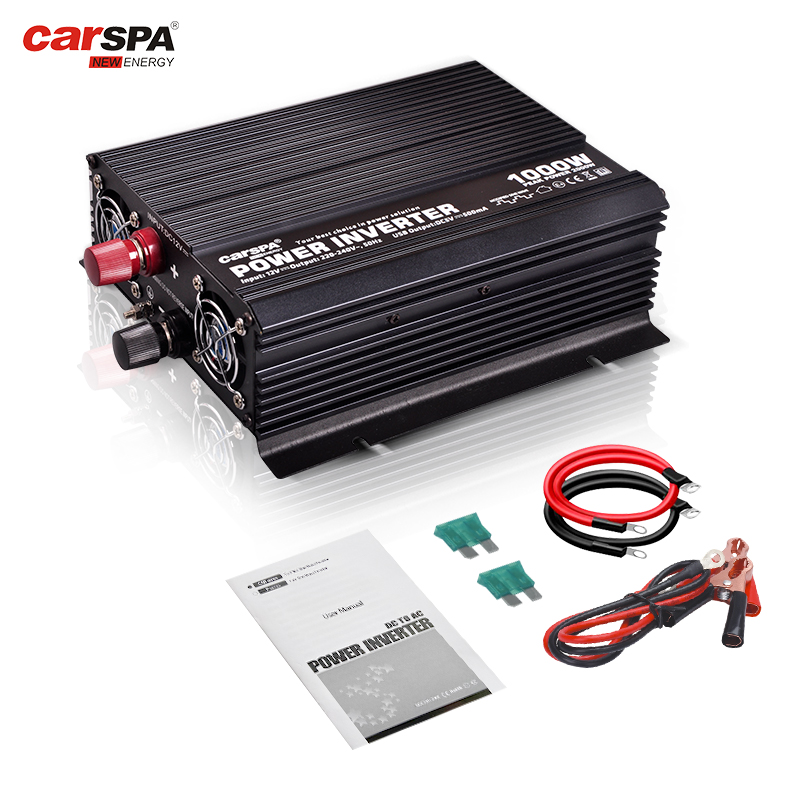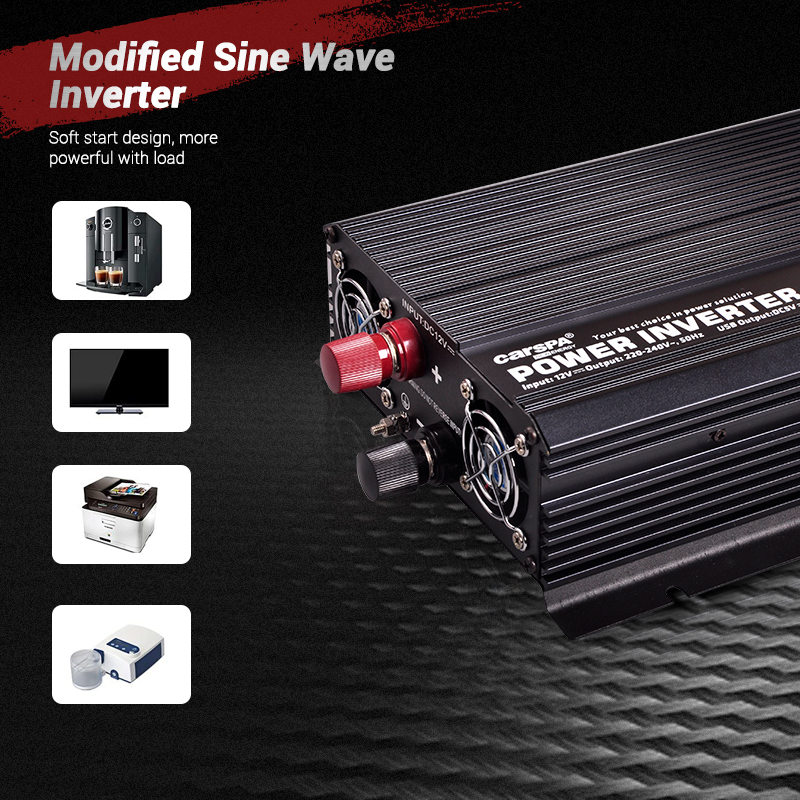How long will a 12 volt battery last with a 1000 watt power inverter And how to calculate between different currents?
In the field of power storage and conversion, the combination of batteries and inverters is a common configuration in off-grid power supply, emergency power supply and portable power systems. Understanding how a 12-volt battery can power a 1000-watt power inverter and how to calculate under different current conditions is key to designing and optimizing the system. This article will analyze it in depth through several common questions.
1. How long can a 12-volt battery power a 1000-watt power inverter?
To determine how long a 12-volt battery can power a 1000-watt power inverter, we first need to understand the battery capacity (Ah, ampere-hour) and the inverter power consumption (W, watt). With this information, we can use some basic formulas to calculate the battery's operating time.
Calculation basis: battery capacity and inverter power consumption
Suppose you have a 12-volt 200Ah battery and the inverter needs to power a device with a power consumption of 1000 watts. The calculation process is as follows:
First, the total energy of the battery (expressed in watt-hours) can be calculated by the following formula:
Total energy (Wh) = battery voltage (V) × battery capacity (Ah)
For a 12-volt 200Ah battery:
Total energy (Wh) = 12V × 200Ah = 2400Wh
This means that the battery is able to provide 2400 watt-hours of electrical energy.
Next, we can calculate the battery's operating time by the power of the inverter. The operating time calculation formula is:
Operation time (hours) = battery total energy (Wh) / inverter power consumption (W)
For a 1000 watt power inverter:
Operation time = 2400Wh/1000W = 2.4 hours
The impact of inverter efficiency
In actual applications, the efficiency of the inverter is not 100%. Usually the efficiency of the inverter is between 85% and 90%. We need to take the efficiency of the inverter into account in the calculation, and the corrected formula is:
Run time = total battery energy (Wh) × inverter efficiency / inverter power consumption (W)
Assuming the inverter efficiency is 90%, the calculation formula is as follows:
Run time = 2400Wh × 0.90 / 1000W = 2.16 hours
Therefore, taking efficiency into account, a 12-volt 200Ah battery can provide power to a 1000-watt RV inverter for about 2.16 hours.
2. How do batteries of different capacities affect the run time?
In addition to the power and efficiency of the inverter, the capacity of the battery also directly affects the run time of the system. How will the run time change if you use batteries of different capacities? Let's analyze several common capacity battery configurations in detail.
Using a 100Ah battery
Assuming you are using a 12V 100Ah battery, the total energy is:
Total energy = 12V×100Ah=1200Wh
Using a 1000W power inverter, assuming 90% efficiency:
Run time = 1200Wh×0.90/1000W=1.08 hours
This means that a 100Ah battery can only support the inverter for about 1 hour.
Using a 300Ah battery
If the battery capacity is increased to 300Ah, the total energy is:
Total energy = 12V×300Ah=3600Wh
For the same inverter, the run time is:
Run time = 3600Wh×0.90/1000W=3.24 hours
After increasing the battery capacity, the system can run longer, with a run time of about 3.24 hours.
Batteries in parallel and series
In practical applications, if a single battery has insufficient capacity, multiple batteries can be connected in parallel or in series to increase the amount of power or voltage. When connected in parallel, the capacity of the battery increases while the voltage remains the same.
For example, when two 12V 100Ah batteries are connected in parallel, the total capacity is 200Ah and the system runtime will double.
3. How to calculate between different currents?
When the inverter runs at different voltages and currents, its power consumption and battery life will vary. In order to accurately calculate the runtime, we need to understand how to convert between different currents.
Basic formula: the relationship between current and power
The relationship between current and power can be calculated using Ohm's law. The formula is as follows:
Power (W) = Voltage (V) × Current (A)
Assuming that the 1000-watt power inverter runs at 12 volts, we can calculate the current consumed by the inverter through the formula:
Current (A) = Power (W) / Voltage (V)
Therefore, the current consumed is:
Current = 1000W/12V=83.33A
This means that the 1000-watt power inverter runs at about 83.33 amps at 12 volts.
Current calculation at different voltages
If the inverter is used at other voltages, such as a 24-volt battery, we can also calculate the current consumption at different voltages. Assuming a 24-volt system, the current for the same 1000-watt load is:
Current = 1000W/24V=41.67A
This shows that the current demand is reduced by half under a 24-volt system compared to a 12-volt system.
4. How to choose the right battery configuration to extend the running time?
When choosing a battery configuration, not only the capacity should be considered, but also the actual operating environment, power consumption requirements, and the battery's charge and discharge characteristics. The following are several key factors to pay attention to when choosing a battery.
Consider the battery's discharge depth
The battery's discharge depth affects its actual service life and available capacity. Most lead-acid batteries have a discharge depth of 50%, which means that although a 12-volt 200Ah battery can theoretically provide 2400Wh of energy, in order to protect the battery life, only half of it, i.e. 1200Wh, can be used in actual use.
Therefore, the actual running time should be adjusted to:
Run time = total battery energy (Wh) × discharge depth × inverter efficiency / inverter power consumption (W)
If the discharge depth is 50% and the inverter efficiency is 90%, the running time is:
Run time = 2400Wh × 0.50 × 0.90 / 1000W = 1.08 hours
Therefore, in order to protect the battery life, the running time will be shortened.
Effect of Temperature on Battery Performance
Battery performance is also affected by ambient temperature. In low temperature environments, the effective capacity of the battery is reduced, which reduces the operating time. For example, in a sub-zero environment, the capacity of a lead-acid battery may drop to 70% of its nominal capacity.
When designing a power system, if it is expected that the equipment will operate in a low temperature environment, it may be necessary to increase the capacity of the battery to compensate for the capacity loss caused by the temperature drop.
How to expand the system by connecting in parallel or in series
To extend the operating time, the capacity can be increased by connecting multiple batteries in parallel. When connected in parallel, the capacity of the batteries is added. For example, when two 12 volt 200Ah batteries are connected in parallel, the total capacity is 400Ah and the total energy is:
Total energy = 12V×400Ah=4800Wh
This can increase the operating time to:
Operation time = 4800Wh×0.90/1000W=4.32 hours
In addition, connecting batteries in series can increase the voltage and reduce the current demand, thereby improving the overall efficiency of the system. For high-power equipment, a reasonable battery parallel or series configuration can effectively extend the operating time and protect the equipment.
Conclusion
How long a 12-volt battery can provide power for a 1000W inverter depends on the battery capacity, the inverter efficiency, and the actual use conditions. The theoretical operating time can be simply calculated through the formula, but in actual application, factors such as the battery discharge depth, temperature influence, and equipment power consumption fluctuations must also be considered.
For different current requirements, reasonable selection of battery configuration and optimization of inverter efficiency can not only extend the operating time, but also improve the overall performance of the system. In actual design and application, understanding these basic principles and calculation methods can help users better manage the battery and inverter system and ensure the stable operation of the equipment.








